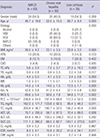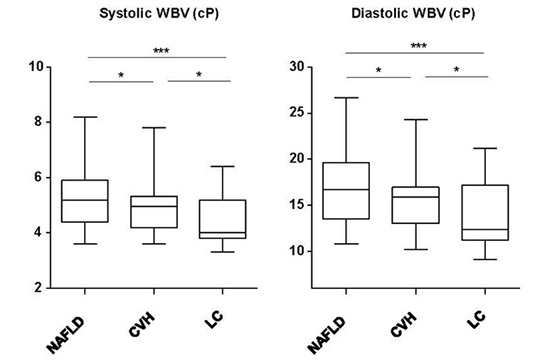1. Omoti CE, Omuemu CE, Olu-Eddo AN. The rheological profile of chronic liver disease patients in Nigeria. Clin Hemorheol Microcirc. 2009; 42:279–284.
2. Tamer S, Cefle K, Gokkusu C, Ademoglu E, Ozturk S, Vatansever S, Palanduz S, Guler K. Comparison of rheological parameters in patients with post hepatitic and alcoholic cirrhosis. Clin Hemorheol Microcirc. 2007; 36:247–252.
3. Anwar MA, Rampling MW. Abnormal hemorheological properties in patients with compensated and decompensated hepatic cirrhosis. Clin Hemorheol Microcirc. 2003; 29:95–101.
4. Tripodi A, Mannucci PM. The coagulopathy of chronic liver disease. N Engl J Med. 2011; 365:147–156.
5. Baskurt OK, Meiselman HJ. Blood rheology and hemodynamics. Semin Thromb Hemost. 2003; 29:435–450.
6. Chen G, Zhao L, Liu Y, Liao F, Han D, Zhou H. Regulation of blood viscosity in disease prevention and treatment. Chin Sci Bull. 2012; 57:1946–1952.
7. Reinhart WH. Molecular biology and self-regulatory mechanisms of blood viscosity: a review. Biorheology. 2001; 38:203–212.
8. Coppola L, Caserta F, De Lucia D, Guastafierro S, Grassia A, Coppola A, Marfella R, Varricchio M. Blood viscosity and aging. Arch Gerontol Geriatr. 2000; 31:35–42.
9. Jung JM, Lee DH, Kim KT, Choi MS, Cho YG, Lee HS, Choi SI, Lee SR, Kim DS. Reference intervals for whole blood viscosity using the analytical performance-evaluated scanning capillary tube viscometer. Clin Biochem. 2014; 47:489–493.
10. Kim S, Cho YI, Hogenauer WN, Kensey KR. A method of isolating surface tension and yield stress effects in a U-shaped scanning capillary-tube viscometer using a Casson model. J Nonnewton Fluid Mech. 2002; 103:205–219.
11. Kim H, Cho YI, Lee DH, Park CM, Moon HW, Hur M, Kim JQ, Yun YM. Analytical performance evaluation of the scanning capillary tube viscometer for measurement of whole blood viscosity. Clin Biochem. 2013; 46:139–142.
12. Shin S, Ku Y, Park MS, Suh JS. Measurement of blood viscosity using a pressure-scanning capillary viscometer. Clin Hemorheol Microcirc. 2004; 30:467–470.
13. Wang K, Wang DS, Fan XP, Li Y. Hemorheologic changes in patients with liver diseases. Zhonghua Shi Yan He Lin Chuang Bing Du Xue Za Zhi. 2003; 17:280–282.
14. Tamer S, Cefle K, Palanduz S, Vatansever S. Rheological properties of blood in patients with chronic liver disease. Clin Hemorheol Microcirc. 2002; 26:9–14.
15. Yang Y, Wang K, Han LY, Li XH, Wang HM. Hemorheologic changes in patients with chronic hepatitis B. Zhonghua Shi Yan He Lin Chuang Bing Du Xue Za Zhi. 2005; 19:61–63.
16. Yu XY, Li Y, Liu T, Wang RT. Association of whole blood viscosity with non-alcoholic fatty liver disease. Clin Hemorheol Microcirc. 2015; 62:335–343.
17. Zhao HY, Li J, Xu M, Wang TG, Sun WW, Chen Y, Bi YF, Wang WQ, Ning G. Elevated whole blood viscosity is associated with insulin resistance and non-alcoholic fatty liver. Clin Endocrinol (Oxf). 2015; 83:806–811.
18. Chalasani N, Younossi Z, Lavine JE, Diehl AM, Brunt EM, Cusi K, Charlton M, Sanyal AJ. The diagnosis and management of non-alcoholic fatty liver disease: practice guideline by the American Association for the Study of Liver Diseases, American College of Gastroenterology, and the American Gastroenterological Association. Hepatology. 2012; 55:2005–2023.
19. Yu KJ, Zhang MJ, Li Y, Wang RT. Increased whole blood viscosity associated with arterial stiffness in patients with non-alcoholic fatty liver disease. J Gastroenterol Hepatol. 2014; 29:540–544.
20. Dong H, Lu F, Wang N, Zou X, Rao J. Type 2 diabetic patients with non-alcoholic fatty liver disease exhibit significant haemorheological abnormalities. Front Med. 2011; 5:288–293.
21. Kurihara T, Deguchi S, Kato J, Furakawa M, Tsuchiya M, Akimoto M, Ishiguro H, Hashimoto H, Niimi A, Maeda A, et al. Impaired blood rheology by remnant-like lipoprotein particles: studies in patients with fatty liver disease. Clin Hemorheol Microcirc. 2001; 24:217–225.
22. Pop GA, Duncker DJ, Gardien M, Vranckx P, Versluis S, Hasan D, Slager CJ. The clinical significance of whole blood viscosity in (cardio)vascular medicine. Neth Heart J. 2002; 10:512–516.
23. Lowe GD, Lee AJ, Rumley A, Price JF, Fowkes FG. Blood viscosity and risk of cardiovascular events: the Edinburgh Artery Study. Br J Haematol. 1997; 96:168–173.
24. Junker R, Heinrich J, Ulbrich H, Schulte H, Schönfeld R, Köhler E, Assmann G. Relationship between plasma viscosity and the severity of coronary heart disease. Arterioscler Thromb Vasc Biol. 1998; 18:870–875.
25. Lee AJ, Mowbray PI, Lowe GD, Rumley A, Fowkes FG, Allan PL. Blood viscosity and elevated carotid intima-media thickness in men and women: the Edinburgh Artery Study. Circulation. 1998; 97:1467–1473.
26. Fischer EI, Armentano RL, Pessana FM, Graf S, Romero L, Christen AI, Simon A, Levenson J. Endothelium-dependent arterial wall tone elasticity modulated by blood viscosity. Am J Physiol Heart Circ Physiol. 2002; 282:H389–94.
27. Seki K, Sumino H, Nara M, Ishiyama N, Nishino M, Murakami M. Relationships between blood rheology and age, body mass index, blood cell count, fibrinogen, and lipids in healthy subjects. Clin Hemorheol Microcirc. 2006; 34:401–410.
28. Park SK, Ryoo JH, Choi JM, Seo MW, Park CM. The risk of abdominal obesity according to the degree of non-alcoholic fatty liver disease in Korean men. J Korean Med Sci. 2016; 31:410–416.
29. Kim MY, Jee SH, Yun JE, Baek SJ, Lee DC. Hemoglobin concentration and risk of cardiovascular disease in Korean men and women - the Korean heart study. J Korean Med Sci. 2013; 28:1316–1322.
30. Min YW, Bae SY, Gwak GY, Paik YH, Choi MS, Lee JH, Paik SW, Yoo BC, Koh KC. A clinical predictor of varices and portal hypertensive gastropathy in patients with chronic liver disease. Clin Mol Hepatol. 2012; 18:178–184.
31. Liu TT, Wong WJ, Hou MC, Lin HC, Chang FY, Lee SD. Hemorheology in patients with liver cirrhosis: special emphasis on its relation to severity of esophageal variceal bleeding. J Gastroenterol Hepatol. 2006; 21:908–913.
32. Polio J, Groszmann RJ. Hemodynamic factors involved in the development and rupture of esophageal varices: a pathophysiologic approach to treatment. Semin Liver Dis. 1986; 6:318–331.
33. Filatova OV, Sidorenko AA, Agarkova SA. The rheological properties of blood depending on age and sex. Fiziol Cheloveka. 2015; 41:110–118.
34. Galduróz JC, Antunes HK, Santos RF. Gender- and age-related variations in blood viscosity in normal volunteers: a study of the effects of extract of Allium sativum and Ginkgo biloba. Phytomedicine. 2007; 14:447–451.
35. Konstantinova E, Tolstaya T, Prishchep S, Milutin A, Mironova E, Ivanova L. Plasma lipid levels, blood rheology, platelet aggregation, microcirculation state and oxygen transfer to tissues in young and middle-aged healthy people. Clin Hemorheol Microcirc. 2004; 30:443–448.








 PDF
PDF ePub
ePub Citation
Citation Print
Print




 XML Download
XML Download